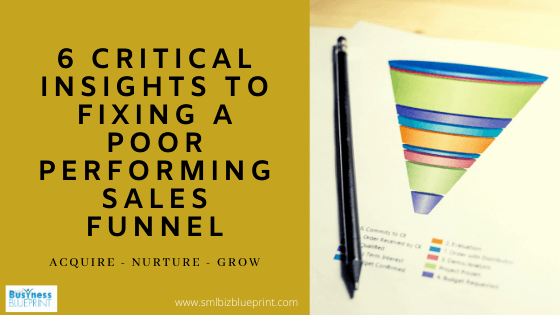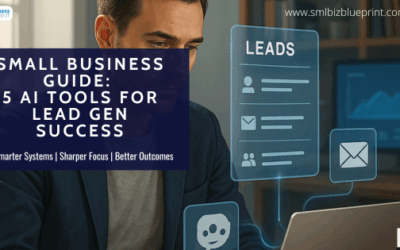The numbers never lie

A competent business owner must be aware of their numbers. One of the most crucial areas is the efficiency of your sales activities.
Over time the sales process for a business has migrated from a physical sales process or steps to a system that is now a digital operation with sales pages and email.
The goal is still the same to generate more sales and thus more revenue without increasing your costs. You want to sell more with less effort or be more efficient.
Why should you spend time and money analysing your sales funnel. You are a savvy business operator who works on instinct, gut feel with your customers so you know what is going on and why customers buy or don’t buy. Or do you?
The numbers never lie.
If your sales funnel is leaking then you are losing customers. Your potential customers won’t be able to flow through your sales funnel toward the point of making a purchase.
You will have wasted your money on all your lead generation or traffic activities.
Let’s look at the numbers from a standard sales funnel of an ecommerce operation:
Image from cxl.com
In the first stage 34% moved on whereas 66% did not. Thus 660 people were lost.
In the second step 14% (or 41% of the 340) moved on but 200 did not.
In the third stage 5% (or 36% of the 140) moved on but 90 did not.
In the end only 22 (2.2%) purchased BUT 978 people did not buy.
How would you feel if you were a door to door salesman and you had to knock on 1000 doors, or make a 1000 phone calls but you would only get 22 sales.
Let’s look at it another way if every phone call or door knock took 30 minutes that means you would have to work 500 hours (or 12.5 weeks) to secure 22 sales.
If you have a high value product that may be good but if you are selling a low value product it is probably deflating.
Imagine what your return would be if you could improve this funnel from 2.2% to 5% then you would go from 22 sales to 50 sales. The good thing is that this does not require you to spend more money on advertising, promotion.
You have to spend time testing, gaining feedback, analysing, implementing and testing again. Building a system that continues to provide you feedback to improving your sales and returns.
Here is another example of a sales funnel from a FB perspective:
Did you see how many leads were lost in both examples. Imagine how much more successful these businesses would be if they paid attention to the performance of their sales funnel, identified problems, improved the performance and then looked for continual improvement.
This is why it is important that you continue to analyse, test and review your steps.
It’s time to troubleshoot your process to identify issues and take action for better results.
Let’s look at how you can analyse your sales funnel and pinpoint areas where you sales funnel is not performing and highlight areas for improvement.
#1: Target the Right Leads
Before you begin any analysis you must be clear on what solutions your business provides for your ideal client. (You do have an ideal client profile don’t you.)
If you are not attracting the right type of client to your business then your sales funnel will fail from day one.
So before you begin any analysis, be clear on who you want as an ideal client, what problems you solve for them, or solutions you provide and how you can add value to their lives and business.
Any concerted effort toward building a better sales funnel needs to begin with building better leads. You need to pursue the people most likely to respond to your product or service.
If you haven’t already, it’s probably time to get serious about learning Google Analytics.
This free service will help you drill down into the nitty gritty of how people are finding you in the first place—whether it’s social channels like Facebook and Pinterest, or whether they’re more likely to find you through organic search results.
#2: Too Many Steps In Your Sales Funnel
Almost everyone has abandoned a shopping cart or turned tail halfway through a signup process.
If you’re hoping to iron out the kinks in your own marketing and sales funnels, you’ll need to eliminate as many bottlenecks and sources of customer consternation as possible.
Reduce the friction. Make the steps easy and not complicated for the customer. Explain everything clearly.
Don’t have too many steps for the customer to reach the goal of your sales funnel. Keep it simple for them.

# 3: Collect Real-World Data About Your Sales Process
In order to find and fix issues with your sales and marketing funnel, and ultimately come up with a way to improve your bottom line, you’ll need a baseline against which to draw comparisons. And that means collecting data—lots of it.
Start with the basics. Start with basic information, such as monthly visitors and your current conversion rate, to help you get a look at the bigger picture.
You couldn’t diagnose an illness without knowing what “healthy” looks like, and you won’t be able to grow your revenue stream before you have strong, historical data from which to draw a comparison.
While there are many details that make up a successful sales funnel, most sales funnel problems fall into two categories — clogs and leaks.
Both can prevent prospective customers from reaching the decision point to become real customers.
Let’s take a look at the causes of these problems:
Sometimes your prospective customers get stuck somewhere between interest and action. You may have done a stellar job of raising awareness and sparking interest through content or a magnet but that’s where your leads stay in the sales funnel.
Some of the same issues that clog your sales funnel can also result in leakage.
Buying decisions are rarely a straight line from awareness to conversion. Delays and distraction may cause potential customers to wander aimlessly, lose interest and drop away.
Competing information can directly (and often purposefully) divert your leads to a competitor.
Social media offers a constant flow of information and competing products. Delays, distraction and diversion create ‘leaks’ in your sales funnel and potential customers will slip away through the cracks.
Step 1: Identify the problem location to understand where to focus your problem solving.
Where are your potential customers getting stuck or lost in the sales funnel?
Visit each stage of your sales funnel to determine where people are getting stalled or lost.
Awareness/Interest phase: This is the top of the funnel where your marketing, communication and engagement strategies will identify and connect with potential customers—or not.
Are your tone and content aligned to attract your target market?
Interest/Consideration phase: This is the middle of the funnel where your sales process informs and guides potential customers to make a decision about buying your product or service—or not.
Does your process inform, respond to and support customer decision making effectively?
Decision phase: This is the lower part of the funnel where potential customers actually decide to become buying customers—or not.
Does your process utilize a clear and effective call-to-action step that will move customers to the point of decision?
Step 2: Clear the clog to keep potential customers moving fluidly from interest to action
Minimize confusion and distraction with clear communication.
Create a seamless multi-channel experience for customers so they know who you are, what you’re offering and what action they should take on every platform.
Chatbots may be a solution to bridge gaps in your process and keep people moving forward. This tool can keep information flowing, improve response time and maintain engagement between more personalized contact.
Step 3: Seal the leak to avoid losing potential customers.
Creating a fresh, interactive and engaging customer experience can help to minimize the distraction of Competing information.
Live media can be an effective tool to engage and build a sense of community.
Building relationships mean that informing, engaging and serving customers is an interconnected series of activities.
Connect marketing & customer service strategies to create a cohesive customer experience that will help keep your potential customers moving toward the decision point.
Step 4: Create a sparkling customer experience so your customers can’t imagine going anywhere else.
Look for opportunities throughout your sales funnel and beyond to continuously improve the customer journey. It’s all about ‘experience’ for millennial shoppers—and most shoppers honestly.
Review and refine the phases of your sales funnel regularly; monthly or at least quarterly.
As you close gaps, improve customer experience and grow customer relationships you will not only solve your sales funnel problem but you’ll gain customers and sales too!

# 4: Adjust Your Sales and Promotions Schedule
It’s time to dive into your traffic by the day of week.
We can defer once again to Google Analytics, but you can just as easily see actual usage data from your own website’s backend—particularly if you use something like WordPress or Medium to publish online.
Does much of the traffic on your site come your way on Sundays?
How about on national holidays?
If you’re beginning to see patterns emerging, it’s time to capitalize on them.
#5: Set Concrete Growth Goals
We’ve already mentioned the importance of gathering benchmarks in order to appraise your success (or lack thereof), but it’s equally as important to set concrete growth goals, so you can see how well you’re measuring up in the future.
Successful resolutions (of the New Years’ variety and otherwise) depend upon clear goals.
A Harvard University study tells us why: Human beings need a heady mixture of motivation and achievement in order to succeed. Online businesses are no different.
Sometimes, the basic approach is the best.
There are other methods out there for keeping tabs on your performance and goals, but an Excel spreadsheet might be the simplest and most effective tool at your disposal.
A spreadsheet lets you set goals on a daily, weekly, and monthly basis and lets you effortlessly track how well you’re doing.
You can record the number of emails you’ve sent, the number of phone calls you’ve had, and how many successful follow-ups you’ve secured.
At an interval of your choosing, you can compare this “real” data with the goals you’ve set.
Achieving steady growth requires something to measure it against—and in this case, your goals can point the way.
It’s healthy to let your hopes and ambitions take the wheel, but it’s still important to keep your expectations realistic.

#6: Not Getting Enough Traffic
You’re going to need more affordable traffic.
That means you need SEO or unpaid social media.
That means you have to create awesome content like this blog post. You have to create something that helps your prospect and you don’t get paid for it.
But it brings in tons of people, some of whom opt into your emails and some of which buy.
Create 2 or 3 sales pages, to test different offers for your prospects.
Trial different ad copy to see which is the best performing ad for attracting your ideal client.
Becoming more efficient at attracting your ideal client will lead to more sales, more revenue and a more profitable business.
Your sales funnel is an important part of your arsenal for attracting potential clients and building your business. Conducting regular testing, reviews and implementing improvements will allow you to grow your business.
Other resources
-
Sales Funnel Definition, Process, Stages and Examples (pipedrive.com) – This detailed educational guide explains what a sales funnel is and why do you need to understand the importance of the sales funnel to build an effective sales process.
-
Funnel Analysis: Finding and Fixing Conversion Problems with Google Analytics (cxl.com) – The conversion funnel is the most important part of every e-Commerce website. It’s where the magic happens: visitors turn into customers, fulfilling the
-
How to Find and Fix Issues in Your Marketing Funnel (convinceandconvert.com) – You don’t need to reinvent the wheel when improving your marketing funnel. These seven actionable strategies can help get you started.
-
What is a Sales Funnel, Examples and How to Create One (Guide) (crazyegg.com) – Do you know what your sales funnel looks like? If not, you’re losing customers. Here’s how to create one that really converts.
Photos courtesy of:
Photo by Antoine Dautry on Unsplash
Photo by Will Suddreth on Unsplash
Photo by Austin Distel on Unsplash




